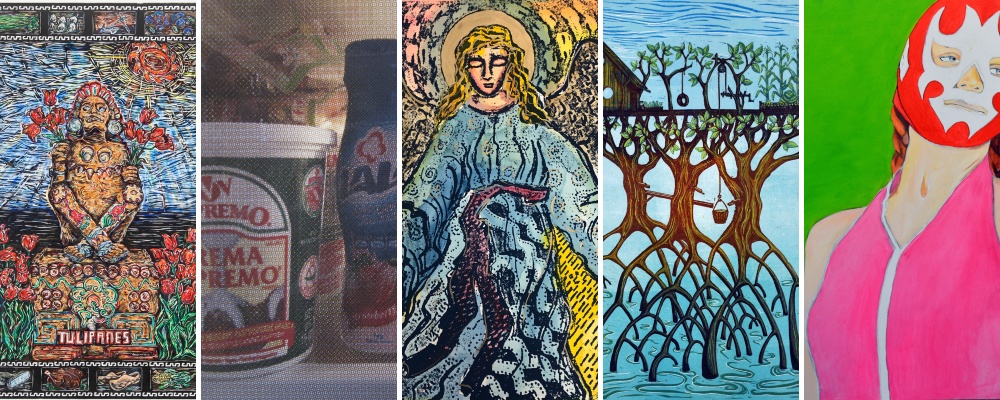Blog
Michigan Artists Representing Mexico
September 01, 2024

Efrain Sandoval, Tulipanes, print, 2001, 2001.298.1a.
Aurora Grajeda, Datos de la Casa, image transfer, 2015, 2015.23.3.
Hugo Claudin, Untitled, acrylic on canvas, 2007, 2015.67.1
Alynn Guerra, Mangrove, reduction print, n.d., 2016.21.1.
José Narezo, Untitled (Angel), mixed media, ca. 1996, 2019.75.1.
Peoples of Mexico created art in various forms as early as 1,500 BCE. Olmecs, the first major civilization in Mexico, used hieroglyphics and calendars representing architectural designs. Archaeological digs have also discovered multiple massive stone head sculptures that may have represented rulers. Mayan and Aztec peoples also became known for their architecture and artistic designs. Ancient mediums included paper, stone, and ceramic, with many examples of figurines, ceramic bowls, wall paintings, and jade sculptures still survive today.
After the Spanish introduced Christianity, European-style designs began to dominate Mexican art, but many artists still included native motifs such as corn, cacao, and architecture. When Mexico later regained its independence from Spain in the early 1880s, artists began to represent a country pulling away from colonial culture and redefining what it meant to be Mexican.
The Mexican Revolution (1910-1917), had a big impact on Mexican art, especially murals. Artists like Frida Kahlo and Diego Rivera worked tirelessly to create images that explored questions of identity, post-colonization, class, and race in Mexican society. Many artists were again inspired by the landscape, religion, and peoples of Mexico.
Rivera’s Detroit Industry Murals are a significant reminder in Michigan of the impact of murals in the ever-changing landscape of America during the Great Depression. While most of the 27 paintings that make up the mural at the Detroit Institute of the Arts depict the manufacturing process and workers at the Ford River Rouge Complex in Dearborn, Rivera also included many personal symbols and connections to his Mexican heritage. For example, Rivera’s depiction of a parts-pressing machine also includes a symbol of the goddess Coatlicure, mother of the moon, stars, and the Aztec gods. Many critics believe that Rivera is contrasting the Aztec story with the role technology would play in the future.
Today, roughly 6% of people in Michigan identify as Hispanic or Latinx. The GVSU Art Museum Collection includes several artists who have lived and worked in Michigan but still uniquely represent aspects of Mexican culture and tradition. Many of their artworks represent cultural traditions that inspire them while representing their own lives as Mexican American artists. While their artworks and stories may be vastly different, they are all connected by their Mexican heritage.
Efrain Sandoval is a local Latinx artist and GVSU alum actively involved in Artes Unidas de Michigan, a community of individuals and organizations working together to advocate Latinx arts and culture in Michigan. This print by Sandoval includes iconic images that represent Michigan and Mexico’s agriculture, landmarks, and religion. It was used at a local art and film festival, Tulipanes, an annual event that celebrates Latinx art, music, and film.
Explore more artwork by Efrain Sandoval.
Aurora Grajeda is a GVSU alumna, now living in Chicago. Her work focuses on their experience as a first-generation Mexican American woman, and the connections and disconnections between her life and that of her immigrant parents. While her cultural roots and traditions inspire her artwork, she also embraces how they have impacted her life differently than generations before her.
Explore more artwork by Aurora Grajeda.
José Narezo was a well-known West Michigan painter, educator, and art advocate with a goal to beautify the city of Grand Rapids while sharing his native Latin culture. The youngest of 12 children, Narezo was born in Mexico and came to the US with his family. Never really leaving his homeland behind, the colors, sites, and religion of Mexico are highlighted throughout his paintings, murals, and mosaics that can be found around the city of Grand Rapids.
Explore more artwork by José Narezo.
Opening on August 26th, 2024, the GVSU Art Museum is featuring a new exhibition, “A Single Thread: Being Latinx in West Michigan.” The exhibition features 13 Latinx artists, representing various countries and cultures of origin and unique perspectives through a multitude of mediums that examine connections to Indigenous histories, hip-hop culture, immigration stories, queer community, agriculture, climate change, disability, identity, trauma, and racism in sports. The following two artists are featured in the exhibition.
Explore more about “A Single Thread.”
Alynn Guerra’s fascination with printmaking began with German expressionist prints and Mexican revolution posters. Through printmaking, Guerra found an accessible and powerful form of art, deeply rooted in empowering social movements. Today, Guerra’s work focuses on climate change, depicting detailed images of ecosystems negatively impacted by Anthropocene- humanity’s relationship to the environment. At first glance, her images may appear dark in nature, but she also includes a touch of humor and irreverence, a nod to her Mexican culture and the posters that influenced her as a young artist.
Explore more artwork by Alynn Guerra.
Hugo Claudin is a Mexican painter who migrated to the United States as a teenager to continue studying art. This painting from his series, "Mexicains Sans Frontieres," reflects his binational status and the secret lives of undocumented immigrants from Mexico. He uses the Mexican wrestler mask as a metaphor for the unseen communities of undocumented people living in the United States and for the misrepresentation in the media, giving them a dignity and cultural richness that is often overlooked.
Explore more artwork by Hugo Claudin.
